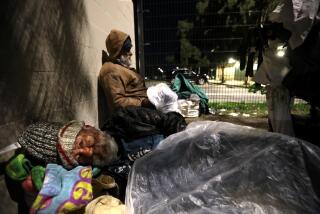Accurate Census Makes Dollars, Sense for Cities : Population: Officials say cities will increase government funding by ensuring the 1990 Census fully counts groups such as the homeless.
Census takers have mounted a campaign to persuade hard-to-reach Westside residents that filling out a 1990 Census questionnaire is in their own best interest.
Despite its image as a relatively affluent area of Los Angeles, the Westside is home to large populations traditionally under-represented in the government head count that occurs every 10 years: ethnic minorities, illegal aliens, non-English speakers and the homeless.
And because much government funding to communities and local agencies is determined on the basis of population, some communities are out to make sure they get their fair shares in the next decade.
âEverybody stands to gain from complete count efforts,â Census Bureau specialist Wanda Flagg said. Flagg is in charge of census promotion efforts in parts of the Westside and South Bay.
In 1980, an estimated 4.6% of the general population was not counted in the city of Los Angeles, including 9% of blacks, 7% of Latinos and 4% of Asians, according to the Census Bureau. Census officials estimate that the undercount for the nation as a whole was 1.5%.
The 1990 Census will be conducted from April 1 to June 30.
Census workers, who will include homeless people deemed qualified for the job and paid $7.50 an hour, will take their first swipe at hard-to-identify Westside residents on the night of March 20 until dawn on March 21.
âWe will first go to shelter sites,â tallying up bodies, Flagg said. âThen from midnight to 2 a.m. we will conduct âstreet enumeration.â After that, we will check out abandoned buildings, under bridges and so forth, until dawn.â
Census workers are given explicit instructions on how to conduct their counts. When counting sleeping homeless persons, for example, enumerators have been instructed not to awaken anybody.
Because trying to count people in dark alleys and underbrush can be dangerous, census workers acknowledge that common sense dictates that they canât count everyone. Some very dangerous areas are strictly off-limits to regular enumerators. In some cases, local people such as gang members who qualify may volunteer to conduct counts in other less stable areas. All who volunteer for such work will be paid $7.50 an hour.
Counting the homeless and other hard-to-identify groups differs from counting of known households, Flagg said, because of built-in uncertainty. Counts such as the one in March give the Census Bureau only an approximation of the number of such residents.
The Census Bureau has 35 staffers at work in California drumming up support for the count among local government officials and residents. Flagg and others, such as Richard Brooks in the Hollywood and West Hollywood areas, have paid dozens of visits in recent months to social service locations, businesses and ethnic gathering places in an effort to convince people of the importance of identifying all residents.
At least two Westside communities have done planning and promotion in advance of the 1990 Census.
West Hollywood, following Santa Anaâs move last January to become the first city in the nation to begin a census promotion, conducted a promotional campaign in 1989.
In Culver City, where officials have said the last census missed too many people, a âcomplete count committee,â has been formed. Flagg said the Culver City committee held its final meeting last week.
âIn Culver City, they really feel they can do much better this time around. They are doing very extensive work,â Flagg said.
Promotional efforts may include such things as informational inserts into city mailings, radio and television spots, notices in public places and flyers sent home with schoolchildren, Flagg said.
By one estimate, each additional person counted in the census will bring an average city more than $600 over the next decade in state tax revenues, which are distributed on the basis of population.
Although $39 billion in federal funds come to California based on population data, Westside census workers say they have found varying degrees of enthusiasm when they pitch their message.
âEfforts vary from city to city. Each cityâs personality, as well as the personality of its elected officials, seem to be the major factor. The cities that respond with full efforts are those that recognize and understand what they have to lose,â Flagg said.
Besides the efforts of West Hollywood, Culver City, West Los Angeles and other areas of Los Angeles such as Hollywood, Flagg said there has not been a great rush to promote the census on the Westside. For example, Santa Monica and Beverly Hills have done little to push the issue, she said.
More to Read
Sign up for Essential California
The most important California stories and recommendations in your inbox every morning.
You may occasionally receive promotional content from the Los Angeles Times.










